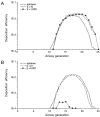A computer model for the simulation of nanoparticle deposition in the alveolar structures of the human lungs
- PMID: 26697441
- PMCID: PMC4671876
- DOI: 10.3978/j.issn.2305-5839.2015.11.01
A computer model for the simulation of nanoparticle deposition in the alveolar structures of the human lungs
Abstract
Background: According to epidemiological and experimental studies, inhalation of nanoparticles is commonly believed as a main trigger for several pulmonary dysfunctions and lung diseases. Concerning the transport and deposition of such nano-scale particles in the different structures of the human lungs, some essential questions are still in need of a clarification. Therefore, main objective of the study was the simulation of nanoparticle deposition in the alveolar region of the human respiratory tract (HRT).
Methods: Respective factors describing the aerodynamic behavior of spherical and non-spherical particles in the inhaled air stream (i.e., Cunningham slip correction factors, dynamic shape factors, equivalent-volume diameters, aerodynamic diameters) were computed. Alveolar deposition of diverse nanomaterials according to several known mechanisms, among which Brownian diffusion and sedimentation play a superior role, was approximated by the use of empirical and analytical formulae. Deposition calculations were conducted with a currently developed program, termed NANODEP, which allows the variation of numerous input parameters with regard to particle geometry, lung morphometry, and aerosol inhalation.
Results: Generally, alveolar deposition of nanoparticles concerned for this study varies between 0.1% and 12.4% during sitting breathing and between 2.0% and 20.1% during heavy-exercise breathing. Prolate particles (e.g., nanotubes) exhibit a significant increase in deposition, when their aspect ratio is enhanced. In contrast, deposition of oblate particles (e.g., nanoplatelets) is remarkably declined with any reduction of the aspect ratio.
Conclusions: The study clearly demonstrates that alveolar deposition of nanoparticles represents a topic certainly being of superior interest for physicists and respiratory physicians in future.
Keywords: Nanoparticles; alveolar region; computer model; deposition; human respiratory tract (HRT); stochastic lung.
Conflict of interest statement
Figures







Similar articles
-
Bioaerosols in the lungs of subjects with different ages-part 1: deposition modeling.Ann Transl Med. 2016 Jun;4(11):211. doi: 10.21037/atm.2016.05.62. Ann Transl Med. 2016. PMID: 27386485 Free PMC article.
-
Theoretical deposition of nanotubes in the respiratory tract of children and adults.Ann Transl Med. 2014 Jan;2(1):6. doi: 10.3978/j.issn.2305-5839.2013.07.05. Ann Transl Med. 2014. PMID: 25332982 Free PMC article.
-
A stochastic model of carbon nanotube deposition in the airways and alveoli of the human respiratory tract.Inhal Toxicol. 2016;28(2):49-60. doi: 10.3109/08958378.2015.1136009. Inhal Toxicol. 2016. PMID: 26895306
-
Deposition, retention, and clearance of inhaled particles.Br J Ind Med. 1980 Nov;37(4):337-62. doi: 10.1136/oem.37.4.337. Br J Ind Med. 1980. PMID: 7004477 Free PMC article. Review.
-
In Vitro Pulmonary Cell Culture in Pharmaceutical Inhalation Aerosol Delivery: 2-D, 3-D, and In Situ Bioimpactor Models.Curr Pharm Des. 2016;22(17):2522-31. doi: 10.2174/1381612822666160202142104. Curr Pharm Des. 2016. PMID: 26831643 Review.
Cited by
-
Radiographic Phenotypes Affect the Risk of Inhaled Corticosteroid-Associated Pneumonia in Patients with COPD.Int J Chron Obstruct Pulmon Dis. 2022 Sep 18;17:2301-2315. doi: 10.2147/COPD.S372735. eCollection 2022. Int J Chron Obstruct Pulmon Dis. 2022. PMID: 36159655 Free PMC article.
-
[Progress in numerical simulation and experimental study on inhalable particles deposition in human respiratory system].Sheng Wu Yi Xue Gong Cheng Xue Za Zhi. 2017 Aug 25;34(4):637-642. doi: 10.7507/1001-5515.201610022. Sheng Wu Yi Xue Gong Cheng Xue Za Zhi. 2017. PMID: 29745565 Free PMC article. Review. Chinese.
-
Theoretical diagnosis of emphysema by aerosol bolus inhalation.Ann Transl Med. 2017 Apr;5(7):154. doi: 10.21037/atm.2017.03.28. Ann Transl Med. 2017. PMID: 28480190 Free PMC article.
-
Characterizing risk assessments for the development of occupational exposure limits for engineered nanomaterials.Regul Toxicol Pharmacol. 2018 Jun;95:207-219. doi: 10.1016/j.yrtph.2018.03.018. Epub 2018 Mar 21. Regul Toxicol Pharmacol. 2018. PMID: 29574195 Free PMC article. Review.
-
A Review of Respiratory Anatomical Development, Air Flow Characterization and Particle Deposition.Int J Environ Res Public Health. 2020 Jan 7;17(2):380. doi: 10.3390/ijerph17020380. Int J Environ Res Public Health. 2020. PMID: 31935991 Free PMC article. Review.
References
-
- Maynard AD, Aitken RJ, Butz T, et al. Safe handling of nanotechnology. Nature 2006;444:267-9. - PubMed
-
- Donaldson K, Aitken R, Tran L, et al. Carbon nanotubes: a review of their properties in relation to pulmonary toxicology and workplace safety. Toxicol Sci 2006;92:5-22. - PubMed
-
- Högberg SM. Modeling nanofiber transport and deposition in human airways. PhD dissertation, Dept Appl Phys Mech Eng, Tech Univ Lulea, Lulea, Sweden, 2010.
-
- Long CM, Suh HH, Koutrakis P. Characterization of indoor particle sources using continuous mass and size monitors. J Air Waste Manag Assoc 2000;50:1236-50. - PubMed
-
- Sturm R. Theoretical and experimental approaches to the deposition and clearance of ultrafine carcinogens in the human respiratory tract. Thoracic Cancer 2011;2:61-8. - PubMed
LinkOut - more resources
Full Text Sources
